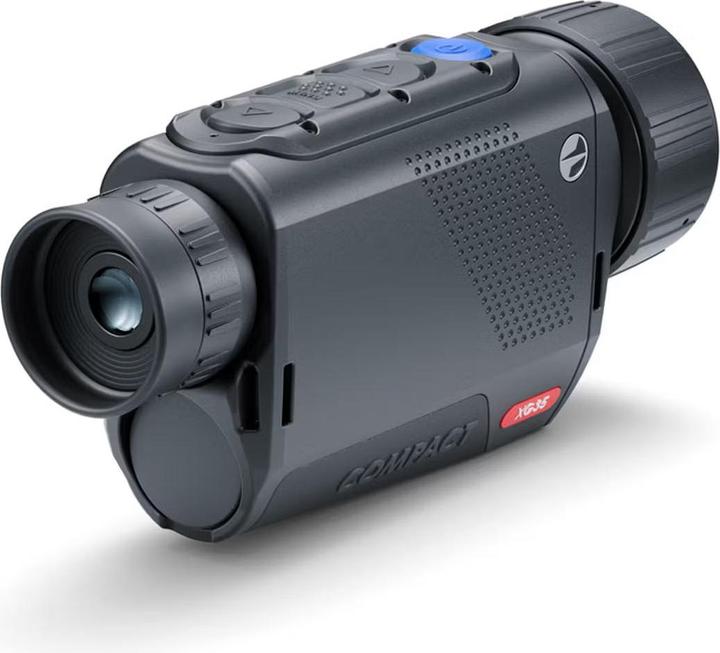

Big game hunting: testing Pulsar thermal imaging devices in the Grisons mountains
In late August 2024, I got a call from Pulsar asking if I’d like to test the thermal monocular Axion XG35 and the Telos XL50.
In late August 2024, I get a call from Pulsar asking if I’d like to test the thermal monocular models Axion XG35 and Telos XL50. This is a no-brainer for me, as I already tested a device once that turned out to be very useful during a hunting session in the Grisons. This time, I’m excited to check out the new technology and the progress in the field of thermal imaging. I receive both models one day before leaving for the hunting grounds in the south of Grisons.
When I arrive at the Alpine hut, I unpack both devices and start taking photos. What really strikes me is their different form and weight factor. Although both devices are monoculars, their specs aren’t the same.

The devices also include some different things.
The Telos XL50 includes the monocular, a rechargeable LPS7i battery with a protective cover, a replacement cover for the battery compartment, a USB-C cable with USB-A adapter, a storage bag, a wrist strap, a quick start guide with a warranty card and a lens cloth.

The Axion XG35 Compact includes the monocular, a rechargeable APS3 battery, a mains charging adapter, a USB-C cable with USB-A adapter, a storage bag, a wrist strap, a quick start guide with a warranty card and a lens cloth.
Same, same but different
The main difference between the two lies in the battery of the Telos XL50 (LPS7i) and the Axion XG35 compact battery (APS3).
Both lithium-ion, but the APS3 is a proprietary form factor suitable for the Axion series and the Merger binoculars. My model has a capacity of 3,200 mAh and a nominal voltage of 3.7 V. The charging time is 3.5 hours. The LPS7i battery of the Telos XL50, on the other hand, has double the capacity with 6,400 mAh and 3.7 V nominal voltage. You charge both batteries directly via the USB-C port on the monocular. The battery of the Telos XL50 can either be charged directly via USB-C or at a power socket using the mains adapter – even when the battery’s been removed. This is only possible with the Axion XG35 Compact by using a charger, which is available separately.
The form factor and weight of the two devices aren’t the same either. Weighing 0.41 kg less, the Axion XG35 Compact is considerably lighter than the Telos XL50. While the Telos XL50 is equipped with a focusing ring and a digital zoom ring, the lens of the Axion XG35 Compact only has a focusing ring.
Here’s a detailed overview of the specs of both devices:
As the spec overview shows, the devices only differ slightly. This is mainly the case with the resolution of the thermal imaging sensor, the objective lens and the detection distance. The Telos XL50 has a higher spatial resolution sensor, which makes the image clearer for the user. At < 40 mK, the thermal resolution is identical for both devices. The Telos XL50 has a greater detection range due to the longer focal length of the lens.
In a few hours, the hunt will begin, so it’s time to charge the batteries and decide on one of the two devices. I’m hoping to spot plenty of game and get good images, so I opt for the Telos XL50. The included storage bag is designed to be worn as a three-point system with the shoulder strap over one shoulder and one over the chest. This makes it lie comfortably at the front of your body. The bag also has numerous loops on the back that offer many fastening options.
However, as I’m travelling with a rifle and a hunting rucksack, the three-point system doesn’t work for me. Instead, I attach the bag to the right-hand strap of the rucksack using cable ties. The case of the Telos XL50 features a flexible lid that makes it easy to quickly access the monocular.
The early hunter sees the game – sometimes
The time has come. 3:30 a.m.: The alarm clock rings an hour earlier than usual. As always before a hunt, my sleep was restless. As Grisons game hunting only takes place once a year for three weeks, it’s like Christmas has come early for us hunters. I packed my rucksack and checked my equipment the evening before. Now all that was left was to fill my thermos flask with hot coffee.
I leave the hut at 4:30 a.m. My destination is about 350 metres higher. We affectionately call it Hell. It’s pitch dark outside. The weather forecast predicts rain. Let’s hope not. I switch on my headlamp, lace up my mountain boots, check the knot won’t come undone and slip into my hunting pants. I check the barrel of my rifle and load it. Next, I switch on the Telos XL50 so it’s good to go. I put on my rucksack and carefully tread across the meadow, mindfully taking one step at a time. The first few days of hunting are often the most successful. That makes weighing up your actions carefully all the more important. The small single trail winding through the forest is wet with condensation from the temperature difference. It was dry the previous day. The drops hanging from the ends of the larch and spruce needles glitter in the light of my flashlight. Cobwebs regularly sweep over my face – a sensation that’s both annoying and nice. They’re also an indicator that I’m the first person to pass this part of the route this morning. I’m alone with my thoughts and forget everything around me. Physical exertion, being outdoors, the fresh and cool air and being alone allow me to relax. I briefly stop at every clearing and take out the Telos XL50. Unfortunately, there’s nothing much to see.
Shortly before I reach Hell, I change my clothes. Dry clothing helps to prevent hypothermia. That’s why I always have a second set with me.

Hell offers a wonderful view of the mountains and a forest aisle with a shooting distance of 200 metres, which is the maximum permitted shooting distance in Grisons.
The sun is slowly rising and the more I can see, the less I rely on the Telos XL50. Thermal imaging devices offer key advantages in the dark and twilight and can be helpful while trailing an animal. During this time of day, the temperature differences are at their greatest and wild animals can be spotted and observed over a great distance. At 11 a.m. it starts to rain. The strong wind sends the rain flying horizontally in my direction. It’s nasty. The fog rises and lifts again. Nothing. This goes on for hours.
Out of boredom, I take a few photos of my surroundings with the thermal imaging camera using different colour palettes, of which there are eight to choose from. The standard settings for the Telos XL50 are White Hot (hot temperatures displayed in white), Black Hot, Red Hot, Red Monochrome, Rainbow, Ultramarine, Violet and Sepia.

Behind me, there’s an anthill. I want to see what it looks like as a thermal image.

The pictures are impressive. The 1,024 × 768 resolution is ideal for creating a high level of detail.
Unfortunately, I’m denied the sight of game during the following few days. The Grisons big game hunt can be cruel. The weather isn’t on my side either. Fog has always been the worst enemy of hunters, because it completely impedes visibility.
With the Telos XL50, fog is no longer a massive problem, as it allows me to see through it. Depending on the density of the fog, this is even possible up to a distance of around 80 metres.

In the evening, I meet my hunting friend Marco and take a portrait photo of him. When looking at the thermal image of him, we noticed a large patch of heat loss in his crotch area. We have a thorough look at his hunting pants and Marco notices that his loden trousers have worn thin after 10 years of hunting in the Grisons. This prompted him to send chuck his beloved loden trousers at the end of the hunt and buy a new pair.

The first half of the hunt flies by. For the second one, I bring along the Axion XG35 Compact. The pressure’s on. I didn’t take a single wildlife snap with the Telos XL50, so I’d better strike lucky with the Axion XG35 Compact. I was all the more delighted to have my wish come true on the very first morning. On the umpteenth ascent into hell, I stop in a wooded area in complete darkness and take out the thermal imaging device. Just to look for heat signatures in the forest. Why not, I think to myself. I spot a hind calf (a young doe) in its bed – in hunting lingo, this means a small animal resting on the ground. It’s spotted me and is staring at me. I carefully take pictures at different magnifications and am delighted.


I stay put for about five minutes, simply observing the animal. There’s not much I can do hunting-wise, as even the smallest movement would make the animal run off into the darkness. I decide to keep going.
Around 50 minutes later, I arrive in Hell. It’s still dark, but dawn is breaking. I take out the Axion XG35 Compact, scan the mountainside and discover two heat signatures 600 metres away. I reach for my binoculars to take a closer look. It’s a cow and calf grazing. I haven’t spotted anything in the huntable forest aisle in front of me, so I can observe the animals in peace. If I’d been using binoculars at dusk, I would’ve had a lot of trouble spotting the animals in the tall grass and among the alpine roses.

Even though nothing more happened in terms of hunting that day, I’m overjoyed to have spotted the animals. Depending on the area, this isn’t a given on the Grisons big game hunt. I’m confronted with this reality over the next few days, during which I’m staring out into the countryside without spotting any signs of wildlife.

After several weeks of hunting with two thermal imaging devices from Pulsar, the Telos XL50 and the Axion XG35 Compact, I’ve come to a conclusion. Which device did I like better? Do I even need a thermal imaging device? I mainly used it to spot game in the early hours of the morning and at dusk.
I’ve come to the following conclusion based on my direct comparison:
The Telos XL50 impresses with a very high sensor spatial resolution, which delivers a razor-sharp image. I particularly liked the two focusing rings, which are easy to operate both with and without gloves. In addition, the larger focal length of the lens increases the detection range to up to 2,300 metres.
The Axion XG35 Compact has a slightly lower sensor resolution, but has the advantage of being handy and lightweight. You can easily stow it in the outer pocket of your hunting jacket and it has a detection range of 1,750 metres, which is perfectly adequate for my hunting needs. Although the Telos XL50 comes with about 500 metres more range, this hasn’t been decisive in my hunting region.
The devices also differ significantly in price. While the Telos XL50 costs between 3,500 and 4,000, the Axion XG35 Compact is significantly cheaper at around 1,700 to 2,000 francs.
My conclusion: I was more impressed with the Axion XG35 Compact. It’s great value for money and meets my requirements perfectly.
Molecular and Muscular Biologist. Researcher at ETH Zurich. Strength athlete.



